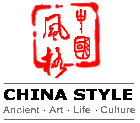Painting in Six Dynasties (220 AD - 589 AD)
History
The disintegration of the Han Dynasty in the early third century A.D., gave rise to the six smaller states. This period has been referred to as the Chinese Middle Ages, which inspired heroic tales such as Romance of The Three Kingdoms, The Five Barbarians and The Six Dynasties.
The six successive dynasties were: the Wu (222-80), the Eastern Ch'in (317-419), the Liu-Sung (420-79), the Southern Ch'i (479-502), the Liang (502-57), and the Ch'en (557-89). Although in a time of severe political disunion, the period of the Six Dynasties was marked by much originality in art, literature, and thought. Poetry, calligraphy and painting flourished despite the turmoil.
Despite the turmoil, China experienced a change in philosophy. Buddhism, which had already been introduced to China from India centuries before, began to flourish. Buddhist art emerged during this period as distinctively Chinese. Buddhist temples, monasteries thrived under imperial patronage.
Art History
Zhang Sengyou (500-550), an early sixth century artist, was credited with many Buddhist wall paintings. His style, included shading, was a departure from the traditional plain washes that dominated Chinese paintings of that period. The new art form was probably imported to China via northern India and the Silk Road from the Mediterranean region.
The Chinese, being practical people, tolerated new styles of art. Shading brought new dimensions to Chinese painting, giving it life-like qualities. Old conventions of fine black lines, flat washes were replaced by fleshy tones as depicted in Zhang Sengyou's "The Five Planets and Twenty-eight Constellations -- Planet Saturn", the only known surviving copy made of his work possibly in the Tang period.
The earliest known great masters of Chinese painting and the earliest known writings on painting theory was artist Xie He (500 - 535). From the Six Canons of Painting, Xie He established the criteria for all aspiring Chinese brush painters:
By order of importance:
1. Animation through spirit resonance - The painter must create vitality in the painting
2. Brushwork - quality of brush strokes matter
3. Natural form - depiction of form must be natural
4. Use of colour - use colour to suit the subject matter
5. Composition - skillful layout of subject matter in a painting
6. Skill in copying earlier masters' works (copying was and still is, a way of learning and absorbing the creative genius of past masters)
One of the surviving painting from the Six Dynasty entitled "The Admonition of the Court Instructess" illustrated the appropriate Confucian behaviour of the subject, in this case the Court Instructess. In the scene, the emperor rejected the approach of the court lady.


